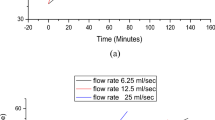Abstract
This study aimed to develop a technically better and economically affordable phase change material (PCM) for thermal energy storage (TES) applications. In this context, the influence of low mass fraction impregnation of graphene oxide nanoparticles (GONP) in the thermal properties of paraffin has been investigated. GONP has been synthesized by modifying Hummer’s method. The morphological, structural and thermal properties of prepared composite PCM have been analysed by different characterization techniques like XRD, FTIR, scanning electron microscope, thermogravimetric analysis, differential scanning calorimetry and laser flash analyzer (LFA). The average latent heat storage capacity of the prepared paraffin/GONP composite is obtained as ~161.34 J g−1, which shows a 27.2% loss in latent heat compared to pure paraffin (225.50 J g−1). Also, only ~3% loss in latent heat has been noticed after 250 thermal cycles, suggesting excellent thermal durability. On the other hand, LFA results showed a 45% increment in thermal conductivity of the paraffin/GONP composite compared to pure paraffin (0.22 Wm−1 K−1). Moreover, the lower mass fraction paraffin/GONP composite showed equivalent latent heat enthalpy and acceptable enhanced thermal conductivity compared to higher mass fraction impregnation. Therefore, the paraffin/GONP composite PCM could be technically and economically more favourable for TES application.











Similar content being viewed by others
References
Sari A and Karaipekli A 2007 Appl. Therm. Eng. 27 1271
Xiao X, Zhang P and Li M 2013 Appl. Energy 112 1357
Zhong Y, Guo Q, Li S, Shi J and Liu L 2010 Sol. Energy Mater. Sol. Cells 94 1011
Zhang Z, Zhang N, Peng J, Fang X, Gao X and Fang Y 2012 Appl. Energy 91 426
Ren W, Cao L and Zhang D 2020 Int. J. Energy Res. 44 242
Yin Z, Huang Z, Wen R, Zhang X, Tan B, Liu Y G et al 2016 RSC Adv. 6 95085
Teng T P and Yu C C 2012 Nanoscale Res. Lett. 7 1
Saydam V and Duan X 2019 J. Therm. Anal. Calorim. 135 1135
Xu Y, Fleischer A S and Feng G 2017 Carbon 114 334
Liu X and Rao Z 2017 Thermochim. Acta 647 15
Rufuss D D W, Iniyan S, Suganthi L and Davies P A 2017 Thermochim. Acta 655 226
Li W, Dong Y, Zhang X and Liu X 2019 Process 7 447
Mills A, Farid M, Selman J R and Al-Hallaj S 2006 Appl. Therm. Eng. 26 1652
JianShe H, Chao Y, Xu Z, Jiao Z and JinXing D 2019 Energy Sources A Recovery Util. Environ. Eff. 41 86
Li M 2013 Appl. Energy 106 25
Zaimi N H M, Nawabjan A, Rahman S F A and Hussin S M 2019 in InECCE2019 Springer, Singapore, p 767
Mehrali M, Latibari S T, Mehrali M, Metselaar H S C and Silakhori M 2013 Energy Convers. Manag. 67 275
Elarem R, Alqahtani T, Mellouli S, El Awadi G A, Algarni S and Kolsi L 2022 Alex. Eng. J. 61 7037
Rawat P S, Srivastava R C, Dixit G and Asokan K 2020 Vacuum 182 109700
Jianguo S, Xinzhi W and Chang-Tang C 2014 J. Nanomater. 276163 6
Harikrishnan S, Magesh S and Kalaiselvam S 2013 Thermochim. Acta 565 137
Yuan K, Liu J, Fang X and Zhang Z 2018 J. Mater. Chem. A 6 4535
Wu T, Hu Y, Rong H and Wang C 2021 Energy 221 119900
Ossonon B D and Bélanger D 2017 RSC Adv. 7 27224
Stobinski L, Lesiak B, Malolepszy A, Mazurkiewicz M, Mierzwa B, Zemek J et al 2014 J. Electron Spectrosc. Relat. Phenom. 195 145
Aulakh J S and Joshi D P 2022 Energy Sources A Recovery Uti. Environ. Eff. 44 986
Aulakh J S and Joshi D P 2022 Polym. Sci. A 64 308
Yang H, Li H, Zhai J, Sun L and Yu H 2014 Ind. Eng. Chem. Res. 53 17878
Zhang B, Tian Y, Jin X, Lo T Y and Cui H 2018 Mater. 11 2205
Author information
Authors and Affiliations
Corresponding author
Rights and permissions
About this article
Cite this article
Aulakh, J.S., Joshi, D.P. Enhanced thermal characteristics of paraffin with low mass fraction impregnation of graphene oxide. Bull Mater Sci 46, 125 (2023). https://doi.org/10.1007/s12034-023-02969-5
Received:
Accepted:
Published:
DOI: https://doi.org/10.1007/s12034-023-02969-5




